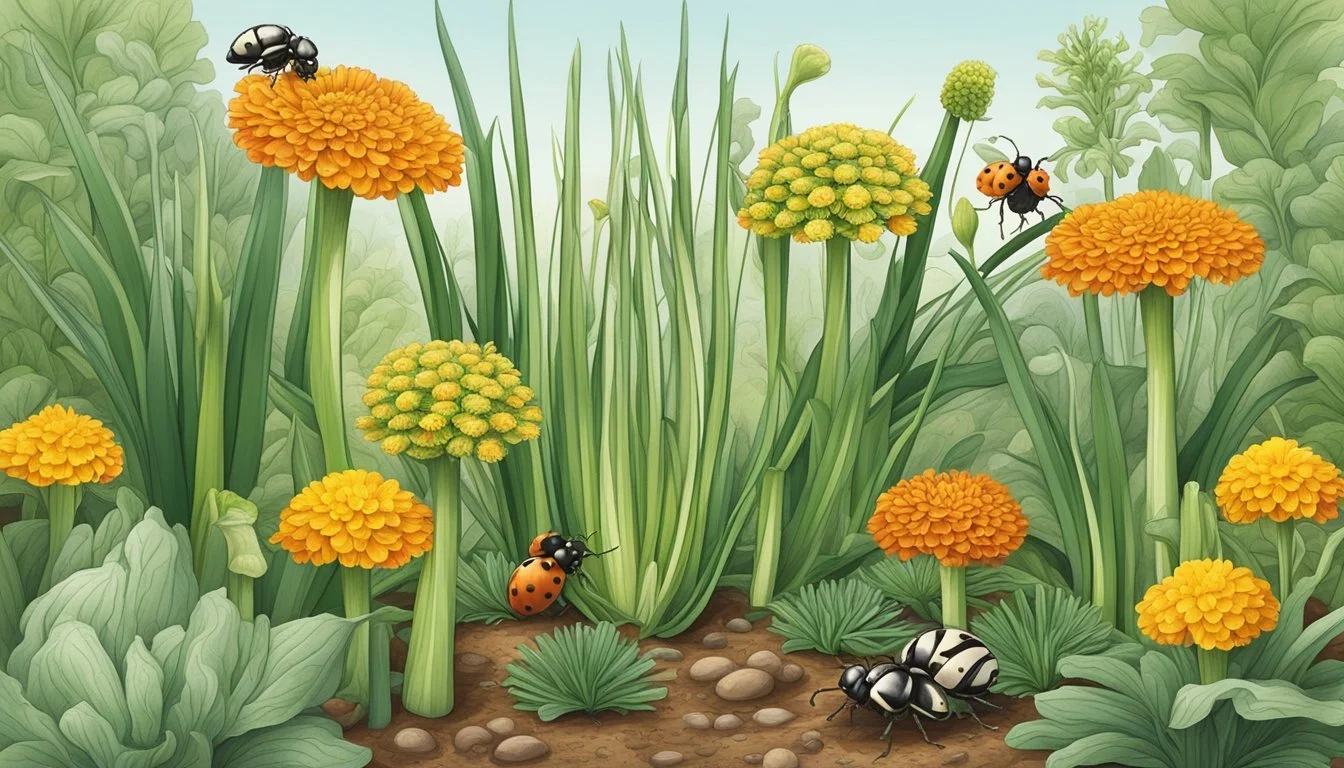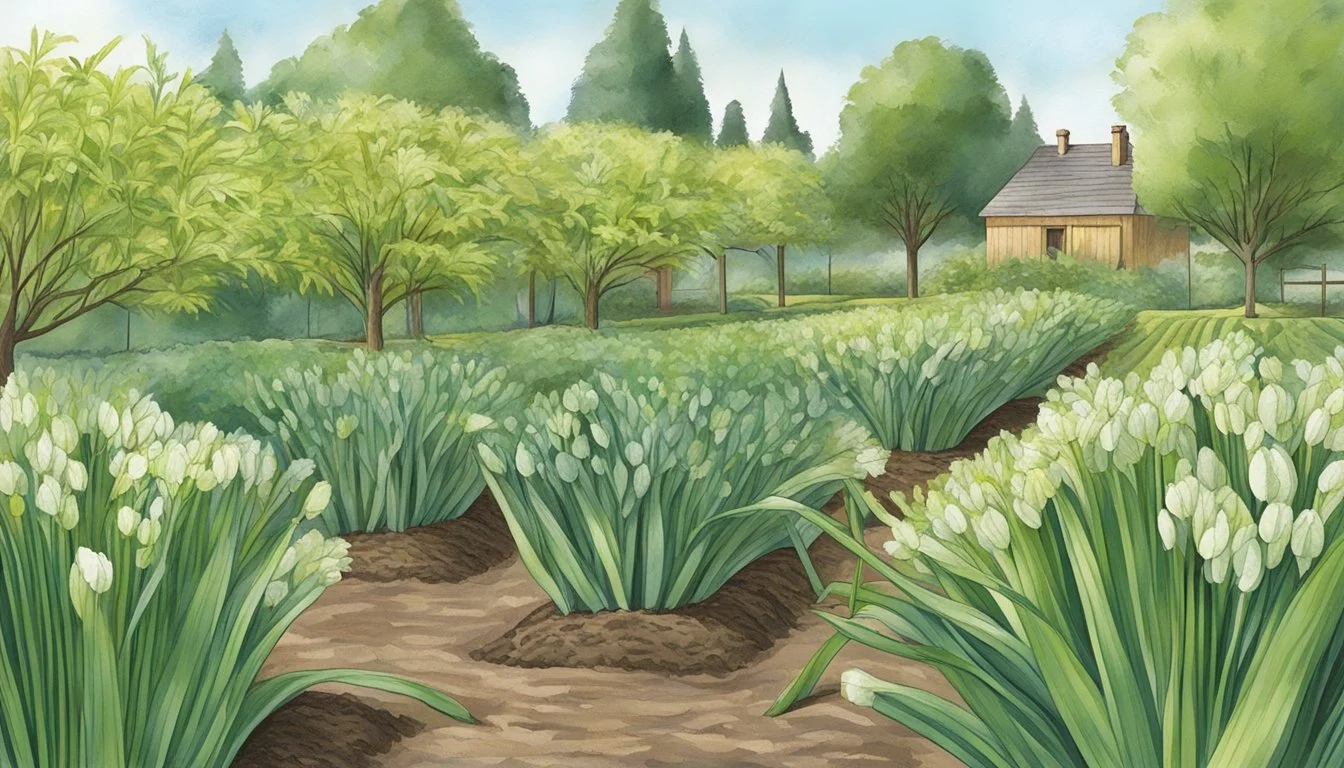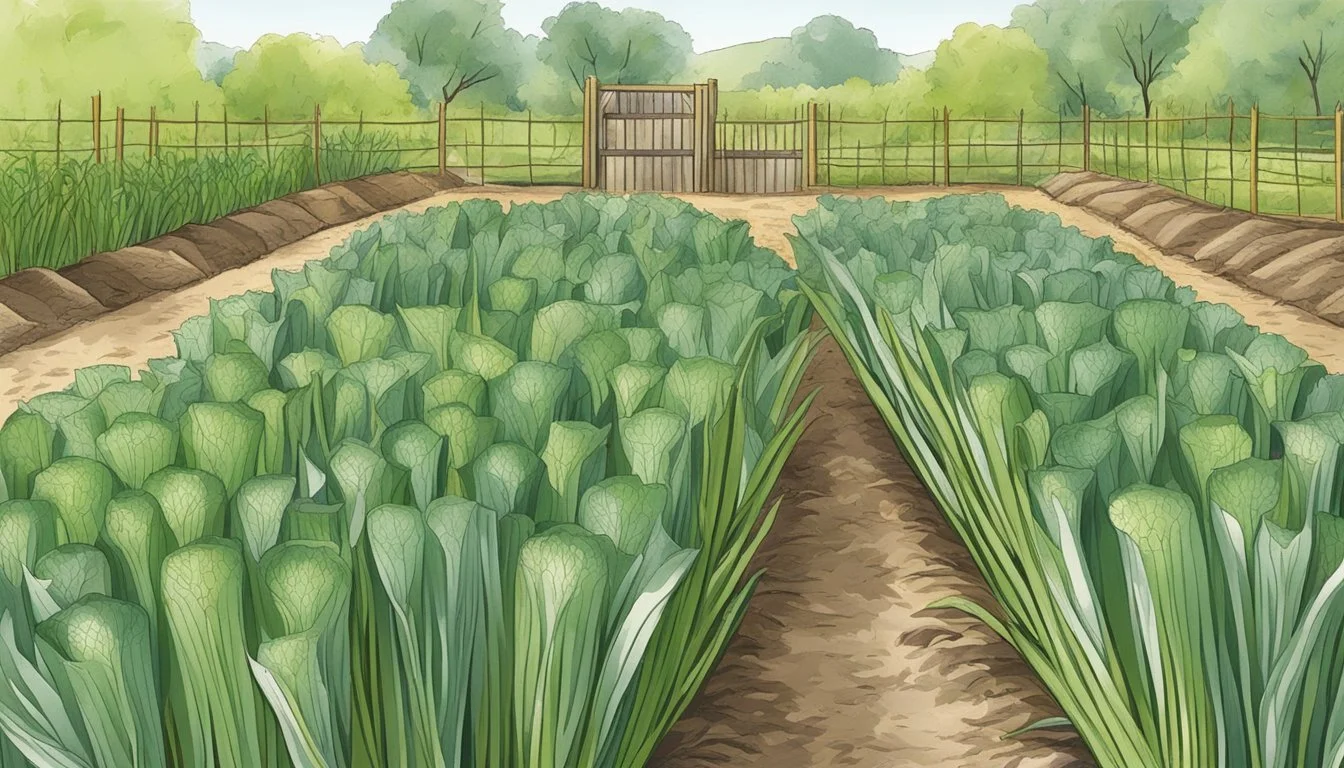Pest Control for Leeks
Effective Strategies for Garden Protection
Leeks, a flavorful staple in the kitchen, are susceptible to a variety of pests and diseases that can hinder their growth and reduce crop yield. To ensure the health and productivity of leek plants, it is essential to implement effective pest control strategies. While natural methods are often preferred for maintaining an organic garden, there are also instances where more direct interventions may be necessary. Identifying the most common threats to leeks early on can make control efforts more manageable and successful.
Among the most prevalent leek pests are the leek moth and thrips, which can cause significant damage to the plants. The leek moth larvae burrow into the leaves and stems, leading to decay, while thrips leave brownish markings and can dry out the leaves. A combination of diligent monitoring and targeted treatments, such as insecticidal soaps or the use of beneficial insects, is critical in managing these pest populations.
In contrast, leek diseases tend to stem from fungal and bacterial pathogens, leading to issues such as rust or white tip disease. Optimal planting practices and crop rotation can prevent many of these diseases, but when they do occur, addressing them promptly with appropriate disease control methods is necessary to prevent spread and save the crop. Maintaining a balance between preventative measures and direct interventions allows for healthy leek cultivation without compromising the integrity of the produce.
Understanding Leek Cultivation
Leek cultivation involves specific considerations regarding soil, planting, and seasonal care to ensure a successful crop of this nutritious vegetable. Below, the optimal conditions and steps for growing leeks are detailed.
Optimal Soil Conditions
Leeks, belonging to the Allium genus, thrive in well-draining loam soil. The ideal pH level for leeks is between 5.5 and 7.0. They need soil that provides adequate nutrients and has the ability to retain moisture without becoming waterlogged. Preparing the soil with organic matter can enhance its structure and fertility, creating an ideal environment for Allium porrum.
Planting and Germination
Seeds should be planted at a depth of 0.6-1.3 cm (0.25-0.5 inches). Germination can be expected with consistent soil temperature—ideally between 18-21˚C (65-70˚F)—and should occur within two weeks. For regions with shorter growing seasons, leeks are often started indoors as seedlings before the spring and then transplanted to the garden.
Seasonal Care
Leeks require regular watering to maintain steady growth, particularly during dry spells in the spring and summer. When leeks are overwintered, they rely on the soil's natural moisture. Mulching can help retain soil moisture and stabilize temperature. Moreover, leeks benefit from cool temperatures; hence, in certain climates, they can be left in the ground during winter and harvested as needed.
Identifying Common Leek Diseases
Effective pest management in leeks begins with the identification of diseases that can impact the plant's health. Recognizing the symptoms early on aids in mitigating the damage and implementing control measures efficiently.
Fungal Infections
Fungal diseases are prevalent in leek cultivation due to their ability to thrive in moist conditions. Key indicators include discoloration and spots on leaves.
Rust: This is characterized by rusty-pustules primarily on the leaves’ surface that can lead to premature leaf drop.
Downy Mildew: Look for fluffy, grey-white growths, usually on the underside of the foliage. In dry weather, infected areas can appear yellow.
Purple Blotch: It presents as small, sunken purple spots that enlarge and often merge, damaging the leek's appearance and marketability.
White Rot: This disease manifests as a fluffy white mold around the roots, often with black sclerotia, leading to plant wilting.
Bacterial and Viral Issues
Bacterial diseases can also affect leeks, usually seen through wilting and rotted tissue.
Bacterial Rot: Key symptoms are soft, smelly decay at the plant base and water-soaked spots on leaves.
Pink Root: Caused by a pathogenic fungus, it leads to pink discoloration of the roots, which later turn purple or black and rot.
Viral diseases are less common but can be spread by insects and cause general stunting or patterning on the leaves.
Environmental Stress Disorders
Environmental stresses cause non-infectious disorders often mistaken for diseases.
Damping-Off: This typically affects seedlings that appear healthy but suddenly collapse. Overly damp soil conditions are conducive to this condition.
Wilting: While it may imply a bacterial or fungal issue, wilting can also result from environmental factors like dry soil or heat stress.
Managing Leek Pests
Effective management of leek pests involves identifying specific insects, implementing mite and nematode control, and establishing prevention strategies. Each of these areas is critical in reducing damage and ensuring healthy leek growth.
Insect Pests
Insects like the leek moth, onion maggots, and thrips can cause significant damage to leek crops. Leek moths, for instance, begin as caterpillars that feed on leaves, then mate as adults, leading to more generations that can decimate leek plants. Similarly, onion maggots emerge from eggs laid at the base of the plant, with larvae tunneling into the stems. Control measures include:
Pesticides: Appropriately labeled insecticidal soaps or neem oil can reduce the populations of these pests.
Biological controls: Introducing natural predators like parasitoid wasps can help keep leek moth populations in check.
Physical barriers: Floating row covers prevent adults from laying eggs on the plants. To learn about controlling leaf miners, visit GP.
Mite and Nematode Control
Although less common than insect pests, mites and nematodes can still threaten leeks. Nematodes can be controlled through:
Crop rotation: Regularly changing crops in fields can break the life cycle of soil-borne nematodes.
Soil amendments: Adding organic matter can promote beneficial organism activity that preys on nematodes.
For mite issues, applying miticides at the right time is crucial for effective control.
Prevention Strategies
Preventive actions are the backbone of pest control in leek cultivation. They include:
Weed control: Weeds can harbor pests, so maintaining a clean field can reduce pest incidence.
Crop rotation: Rotating with non-host crops interrupts pest life cycles.
Sanitation: Removing crop residues can eliminate overwintering sites for pests.
By understanding the behaviors and life cycles of leek pests, growers can implement targeted strategies to protect their crops. For example, traps and monitoring can help determine the best time for control actions.
Note: The effectiveness of pest control methods can vary depending on environmental conditions and pest populations. It is always recommended to seek advice from an agricultural extension officer or a professional pest management service for specific issues.
Leek Specific Pests and Diseases
Leeks (Allium porrum) are susceptible to a variety of pests and diseases that can hinder growth and reduce yield. Understanding these concerns is crucial for effective management and healthy leek production.
Thrips and Maggots
Thrips, specifically the leek thrip (Frankliniella occidentalis), present as tiny insects causing brownish markings and potential drying of leek leaves. Effective control measures include regular surveillance and the use of chromatic traps.
Onion Maggot (Delia antiqua): These pests lay eggs near the base of the leek. Maggots then move into the soil to feed on the roots, which can lead to crop failure. Rotating fields annually can help reduce the occurrence of onion maggots in leeks.
Fungal Challenges
Botrytis, or botrytis leaf blight, is a fungal disease that manifests as gray mold on leek foliage. It thrives in humid conditions and requires adequate air circulation and moisture control for prevention.
Downy Mildew and white rot are additional fungal diseases that can affect leeks. Downy mildew is characterized by fluffy white fungal growth, while white rot leads to soft, rotted bulbs. Implementing crop rotation and proper sanitation reduces the spread of these diseases.
Treatment and Control Methods
Effective pest control in leek cultivation involves a diversified approach, including chemical treatments, organic methods, and physical and biological strategies, each with a specific role in maintaining healthy crops and managing pest populations.
Chemical Treatments
Insecticides: Chemical insecticides can be used to directly target pests in the field. A judicious application of a fungicide may be necessary when a fungal problem threatens the health of leek plants. Care must be taken to apply these products correctly to minimize harm to non-target organisms and to prevent the development of resistance.
Organophosphates: For treating pests like Hylemya antiqua, which affects leeks, organophosphate-based insecticides may be effective.
Organic Approaches
Neem Oil: Neem oil serves as both a pest repellent and as a substance that can interfere with pest life cycles. Regular spraying can effectively minimize pest populations.
Insecticidal Soap: This is useful in controlling soft-bodied insects that can affect leeks, such as aphids and mites. Insecticidal soap works by breaking down the insect's outer layer, leading to dehydration.
Pheromone Traps: These can be strategically placed around the leek field to monitor and control pests by disrupting their mating behaviors.
Physical and Biological Measures
Promoting Air Circulation: By ensuring good air circulation within the leek field, one reduces the humidity levels that can lead to fungal diseases.
Crop Rotation: Implementing crop rotation can help prevent the build-up of soil-borne pests and diseases.
Biological Controls: Introducing natural predators or parasites of leek pests can help keep pest populations in check.
Preventative Cultivation Practices
Effective pest management in leek cultivation begins with preventative measures. These practices not only reduce the incidence of pests and diseases but also promote overall plant health and productivity.
Crop Rotation and Companion Planting
Crop rotation is essential to disrupt the life cycle of specialized pests and diseases. By not planting leeks in the same spot more than once every three to four years, it reduces the risk of soil-borne diseases like white rot. This rotation can be effectively paired with companion planting, where leeks benefit from being planted alongside lettuce, carrots, and potatoes. These companions can deter pests and enhance air circulation around the plants.
Sanitation and Field Management
Maintaining a clean growing environment minimizes pest infestations. One should remove plant debris, which can harbor pests and diseases, thus preventing the problematic growth of larva and the appearance of orange spots on leaves. Strategic spacing of rows allows for better air circulation and can reduce fungal issues because of drier foliage. It is also important to consistently manage weeds, as they can attract pests and compete with leeks for nutrients.
Soil Health and Fertility
Healthy soil fosters strong plant growth, making them less susceptible to pests and diseases. Soil pH should be monitored, as leeks prefer a pH around 6.5 to 7.0. Adding organic matter and ensuring a balanced supply of nutrients can improve soil structure and fertility. Moreover, practices like mulching can regulate soil temperature, keep roots cool, and further enhance weed control.
Monitoring and Regular Maintenance
One must establish a consistent monitoring routine to mitigate the risks posed by pests and diseases in a leek field. Regular maintenance is key to identifying symptoms early and managing potential problems efficiently.
Weekly Inspections
A vigilant observer should conduct weekly inspections, searching for signs of common leek pests such as thrips or the leek moth. Identifying the presence of pests early can circumvent the spread and minimize the damage.
Pest Symptoms: Silvery streaks on leaves may indicate thrips.
Disease Signs: White patches on the soil could suggest white rot.
Immediate Actions
Upon detection of any anomalies:
Isolate affected plants to prevent the spread of disease or pests.
Remove and destroy infected plant material promptly and safely.
Maintenance Practices
Cultural Controls:
Crop Rotation: This helps reduce the build-up of soil-borne pathogens.
Sanitation: Keeping the field free from debris limits disease spread.
Physical Controls:
Use barriers, such as row covers, to protect crops from moths.
Regular weeding prevents competitive stress and reduces hiding spots for pests.
Documentation
It is advisable to keep a logbook recording:
The occurrence and extent of any pest or disease found.
All actions taken, including the use of any pesticides or organic treatments.
This documentation aids in tracking the efficacy of control measures and supports improved decision making for future crop cycles. Implementing consistent monitoring and maintenance strategies maintains the health of the leek crop and can lead to successful harvests.
Frequently Asked Questions
This section provides direct answers to some of the most common questions regarding leek pest and disease management, giving clear guidance for growers.
How can I identify and control common diseases affecting leeks?
Common diseases in leeks, such as rust or white tip disease, typically manifest as discoloration or spots on leaves. For control, cultural practices such as crop rotation and improved air circulation are crucial. In some cases, fungicides might be necessary. It's essential to identify the disease accurately for appropriate treatment.
What are the most effective pest control measures for leeks?
Effective pest control for leeks includes using insecticidal soap or neem oil to combat common pests like thrips or aphids. Regular monitoring and early intervention are key to preventing an infestation. Employing integrated pest management strategies can also be beneficial.
What should I do if my leeks have collapsed?
If leeks have collapsed, it can signal root problems or an infection such as soft rot. It's important to remove affected plants to prevent spread and investigate the root zone for signs of decay or pests. Ensure that leeks have proper drainage and avoid overwatering to reduce the risk of rot.
Is it safe to eat leeks affected by Allium leaf miner?
Leeks damaged by Allium leaf miner larvae may still be safe to eat after removing the affected parts, but the quality and taste may be compromised. It's advised to discard heavily infested parts as they might harbor secondary infections.
Which herbicides are recommended for use with leeks?
Herbicide use with leeks should be limited to products labeled safe for leek crops. Pre-emergent herbicides can be used to control weed pressure, but it's imperative to follow the manufacturer's instructions and apply only at recommended times to avoid harming the leeks.
How do I prevent insects from eating the tops of my leeks?
To prevent insects from eating the tops of leeks, consider using floating row covers to physically block pests, or apply appropriate insecticides as a preventative measure. Encouraging beneficial insects that prey on pests can also be part of an effective biological control strategy.







